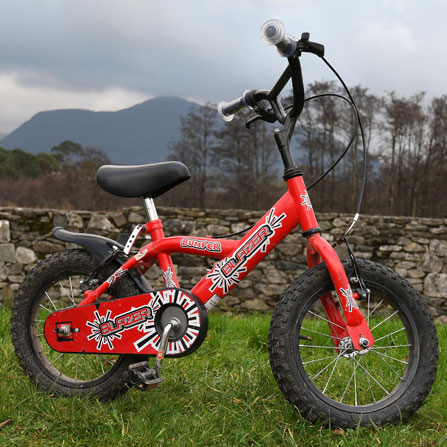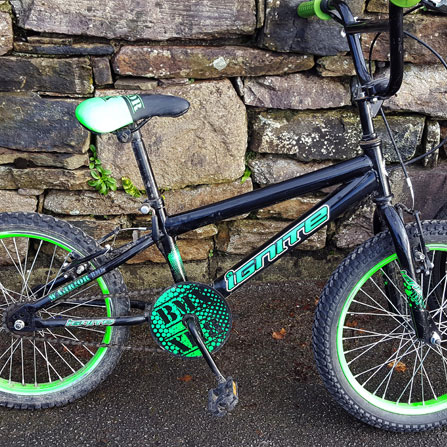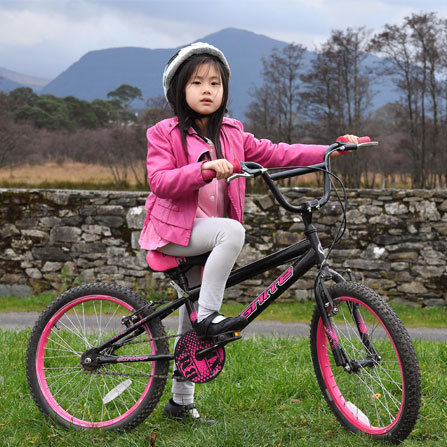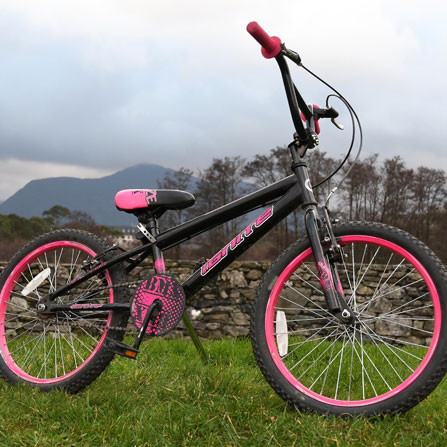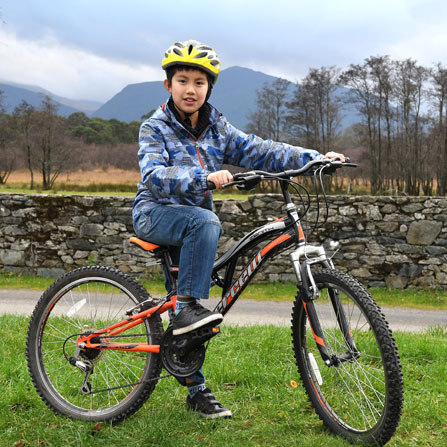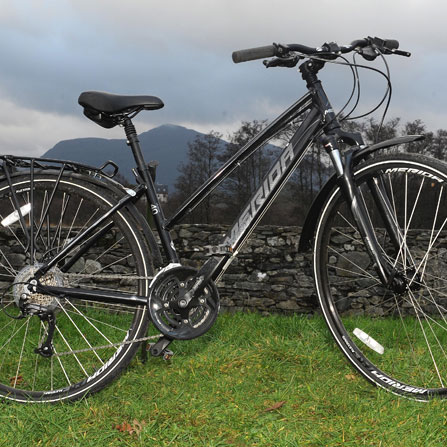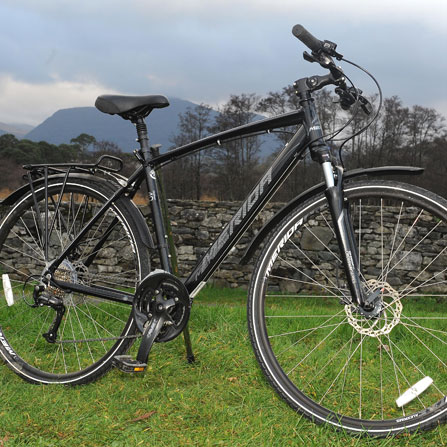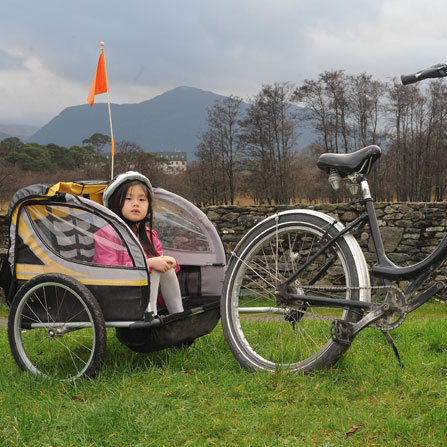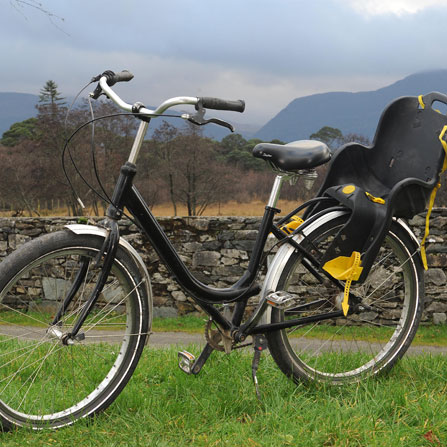Swipe to view images
Muckross Cycle Tour
Park the car, rent a bike and head for cycle heaven in the heart of Killarney National Park. Pedal in safety to places that vehicles can't get near and stop and go as you please, taking in the spectacular sights, sounds and smells along the way.
Our business, Cycling Killarney, is based on Muckross Road, 1km from the town, on the N71, adjacent to the Gleneagle Hotel and Flesk Caravan Park. We are directly opposite the cycle path, making it ideal and safe for families.
Our staff are happy to show you a variety of bicycles suitable for adults and children and offer a voice of experience. Safety is our priority so once your bike has been adjusted for your comfort, you will be provided with a helmet. A free map will help you explore the many beautiful sights and historic buildings of Killarney National Park.
We offer a number of suggested routes:
Route 1:
This takes in Muckross Abbey, Muckross House and Traditional Farms and Torc Waterfall and is entirely within the National Park where cars are not permitted. Suitable for children's bikes, buggies and bicycles with baby seats.
Route 2:
This involves an anti-clockwise cycle around Muckross Lake, a 0.8km/0.5mile cycle on the N71 road, taking in all the sights included on Route 1.
Note: This is a one-way system around the lake. This route is recommended for adults only.
Swipe to view images
Route 1: Muckross Abbey; Muckross House and Gardens; Muckross Traditional Farms and Torc Waterfall
Directly opposite the Cycling Killarney depot is the cycle path to the National Park. After passing fine views of Loch Lein your first stop is Muckross Abbey. Built in 1448, it was founded as a Franciscan friary by local chieftain Donal McCarthy Mor. It contains tombs of Gaelic chieftains, eerie chambers and gloomy staircases. It was here in 1588 that Florence McCarthy married his cousin, Lady McCarthy, in a secret midnight wedding.
Several monks were murdered when the abbey was looted and burnt by Cromwellian soldiers in 1652. A mysterious hermit lived for many years in the upstairs kitchen. History, intrigue, scary bits - it's all here.
A short distance further is one of Ireland's most popular visitor attractions, the focal point of the National Park, Muckross House, a Victorian mansion built by Henry Arthur Herbert in 1843. Following turbulent times, the house, gardens and lands were gifted to the Irish nation by the then owner Arthur Vincent in 1932.
Among the famous visitors that stayed at Muckross House were Queen Victoria, Prince Albert, King Edward VII, British Prime Minister Arthur Balfour, Empress Eugenie of France, George Bernard Shaw and William Butler Yeats. Double Oscar nominated Hollywood star Michael Fassbender was inducted into the prestigious Order of Innisfallen - the highest honour Killarney can bestow - at a ceremony in Muckross House in October 2016.
The House is surrounded by beautiful gardens. They are particularly colourful in May when the rhododendron is in bloom.
Adjacent to the Muckross House are Muckross Traditional Farms. Step back into the past and visit a very different Ireland, as lived the 1930s and 1940s. Back then, a trip to the well for water was still a daily chore for the housewife and electricity had yet to be introduced to the countryside.
While admission to the Gardens is free, there is a charge for entry to the House and Traditional Farms.
From Muckross House follow the road within the National Park to Torc Waterfall. When you arrive at the jaunting car parking area, look for the under-road tunnel on the right by the river. You can park your bicycle here. The 20m (65ft) falls are spectacular, particularly after rain. There is no entry charge.
Rather than taking the N71 back to the Cycling Killarney depot, it may be best to retrace your tracks through the National Park. It is a beautiful cycle beside Muckross Lake and Dundag Beach which is located half way between the waterfall and Muckross House. Note the Arthur Young Walk which is a spectacular hiking path, starting at Muckross Boathouse and taking you around the peninsula, past Dundag Beach and back to the boathouse. You can park your cycles at the boathouse.
Swipe to view images
Route 2: Muckross Abbey; Brickeen Bridge, Dinis Cottage, Meeting of the Waters, Old Weir Bridge, Torc Waterfall, Muckross House and Gardens, Muckross Traditional Farms
Directly opposite our Cycling Killarney depot is the cycle path to the National Park. After passing fine views of Loch Lein, our first stop is Muckross Abbey - look out for it on your left. At the Y-junction turn left for about 200 yards to the abbey.
Built in 1448, Muckross Abbey was founded as a Franciscan friary by local chieftain Donal McCarthy Mor. It contains tombs of Gaelic chieftains, eerie chambers and gloomy staircases. It was here
in 1588 that Florence McCarthy married his cousin, Lady McCarthy, in a secret midnight wedding.
Several monks were murdered when the abbey was looted and burnt by Cromwellian soldiers in 1652.
A mysterious hermit lived for many years in the upstairs kitchen. History, intrigue, scary bits - it's all here.
After visiting Muckross Abbey return to the Y-junction and continue on your route to Dinis Cottage. From here the road passes in and out of lush, mossy
woodlands, punctuated by constantly changing views of the lakes and mountains. Keep right to stay on course.
As you leave the wooded area you will get your first glimpse of Muckross House on your left. Don't be tempted to visit it at this point as we will be closer to it on the return journey.
Soon passing a pretty pink cottage and Arthur Vincent House, you enter the Natural Zone of the National Park, the realm of native woods and deer. A little lake on the right marks a geological divide from limestone to sandstone. Notice how vegetation and tree types change abruptly.
After Brickeen Bridge, where the water flows from Muckross Lake to the Lower Lake, you arrive at Dinis Island. Immediately after leaving the cottage you cross a little bridge. On your right you will notice signs for the Meetings of the Waters and the Old Weir Bridge. It's worth taking the five-minute walk for the views and photo opportunities. If you happen to be there in the early afternoon, you will see the boats returning from the Gap of Dunloe tour. Take note that the Dinis road is a one-way system.
1.6km ahead is the main road. Turn left and beware of vehicles on the main road. Not suitable for small children - please exercise caution
Another 800m brings you to Torc Waterfall. After viewing the spectacular, cascading waterfall, cross the main road, though the jaunting car parking area and into the National Park.
The next stop is Muckross House, Muckross Gardens and the Traditional Farms. Muckross House is a Victorian mansion built by Henry Arthur Herbert in 1843. Following turbulent times, the house, gardens and lands were gifted to the Irish nation by the then owner Arthur Vincent in 1932.
Among the famous visitors that stayed at Muckross House were Queen Victoria, Prince Albert, King Edward VII, British Prime Minister Arthur Balfour, Empress Eugenie of France, George Bernard Shaw and William Butler Yeats.
The house is surrounded by beautiful gardens. They are particularly colourful in May when the rhododendron is in bloom.
Adjacent to Muckross House are Muckross Traditional Farms. Step back into the past and visit a very different Ireland of the 1930s and 1940s. Then, a trip to the well for water was still a daily chore for the housewife and electricity had yet to be introduced to the countryside.
While admission to the Gardens is free, there is a charge for entry to the House and Traditional Farms.
Leave Muckross House by the tree-lined avenue in front of the house and you will find yourself back at the junction where you turned for Dinis Cottage. Keep right, following directions for Muckross Abbey and Killarney town.
Swipe to view images
Route 3: Killarney House, Knockreer Estate, Deenagh Cottage, Ross Castle
Cross the road to the cycle path and turn right for Killarney town for 2km. At the first roundabout, at the junction of Muckross Road/Countess Road, is the entrance to Killarney House and Gardens. Please exercise great care as this is a busy road with vehicular traffic. Take some time to visit but please note that cycling in not permitted in the grounds but you can walk your cycle the short distance to the entrance to Knockreer Estate, part of Killarney National Park.
Continue on until you cross a bridge and arrive at the pretty thatched Deenagh Cottage. Follow the signposts from here to Ross Castle. The route follows the Deenagh River until it enters Loch Lein and then follows the lake shore to Ross Castle. The castle gives a real insight into the life of an Irish chieftain in medieval times.
Ross Castle stands on the shores of Loch Lein. It was built in the late 15th century by the local ruling clan, O'Donoghue Ross. A typical tower house, it was surrounded by a fortified wall defended by circular towers, of which only two remain. Ross was one of the last castles in Ireland to surrender to Oliver Cromwell's forces in 1652. The Cromwellians dragged gun-boats up the River Laune and surprised the occupants by attacking the castle from the lake. The castle is authentically restored and contains 16th and 17th-century oak furniture.
Open March-October, 9.30am-17.45pm.
From the castle take Ross Road to the junction of Muckross Road, the first set of traffic lights. Turn right here, cross Flesk Bridge, the Brehon Hotel and the Gleneagle Hotel on your left and you're back at our depot.
Swipe to view images
Gap of Dunloe
text required.
Swipe to view images
Ring of Kerry
text required


